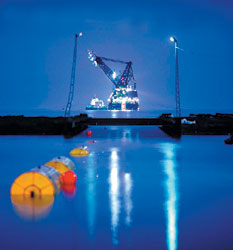Massimo Pulici, Saipem Energy International S.p.A. The Blue Stream project is one of the most challenging of its type ever attempted due to difficulties in design, construction, organization and logistics. Thus far, the Saipem 7000 lay barge has successfully installed the first 24-in. pipeline in the Black Sea, in waters 7,054 ft deep. Work is proceeding along the entire route, on land and offshore, with completion scheduled for the second half of 2002.
The project also calls for installation of a gas compression and transportation system between Russia and Turkey. This includes design / construction of a compressor station on the Russian side and a gas pipeline crossing the Black Sea from Djubga, Russia, to Samsung, Turkey. The 775-mi system will include: a 56-in., 230-mi line across Russia owned by Gazprom; two 24-in. pipelines across the Black Sea and 290 mi of 48-in. pipeline linking up with pipeline networks at Ankara, operated by BOTAS. Blue Stream is owned by a partnership comprising Gazprom, the Russian National Hydrocarbon Company, and Snam of the ENI Group. Saipem was awarded the Blue Stream project by BSPC (a Gazprom / Snam joint-venture) in November 1999. The award was preceded by more than one year of intensive technical evaluation and negotiations. The turn-key, lump-sum project is being carried out by Saipem, as leader of a consortium of contractors comprising Saipem, Bouygues Offshore and a Japanese Consortium (Mitsui, Sumitomo, Itochu). Saipem’s portion of the work comprises design, procurement, construction and pre-commissioning of two 24-in., 1-1/4-in. wall thickness lines between Russia and Turkey. Maximum water depth of the Black Sea crossing will reach 6,900 ft. Bouygues Offshore’s portion includes design, procurement, construction and commissioning of the compressor station, which pressurizes the gas to 25 Mpa (3,625 psi). The Japanese consortium’s segment consists of production and supply of the 24-in., 1-1/4-in. wall pipe, including internal coating and external polypropylene. The significance of the Blue Stream project derives from the unprecedented difficulties of the two sea lines. Geotechnical, geomorphological and bathymetric characteristics of the regions to be traversed presented varied and challenging features. Ultra-deep water, an H2S environment, steep slopes and geo-hazards are the key design considerations that Saipem and its engineering subcontractor Snamprogetti have faced during design, installation engineering and construction. The routes of the two 24-in., 1-1/4-in. wall lines differ only on the Russian Shelf and Upper Russian Slope, where they join and run parallel up to the Turkish landfall. Route E1 is about 236 mi long, while route W2 (the first line recently laid) is about 240 mi long. Maximum water depth achieved is 7,054 ft, the deepest sea line ever laid. The laying of some 200 mi of pipeline in water depths exceeding 3,280 ft, plus 124 mi in waters exceeding 6,500 ft, tested the J-lay system capacity. Before analyzing Saipem 7000’s performance on the Blue Stream Project, it is appropriate to qualify the design approach adopted by the engineers. Primary construction parameters are severe, not only in avoiding costs and delays while repairing possible pipe damage during construction in deep water, but especially in maximizing the system’s life expectancy, with special consideration for hydrogen-induced cracking (HIC). Hence, high-quality pipe materials and welding specs are required, followed by automated ultrasonic inspections. Additionally, the maximum strain level allowed is less than 0.15%. Saipem 7000 laid the pipelines with an average production rate of 9,845 ft/day, with peaks of 15,750 ft/day. Precision laying was achieved, without any abandonment or recoveries due to bad weather. No buckles occurred during any operations, and no sizeable damages were registered, even under extreme environmental conditions. |
|||||||||||||
- Advancing offshore decarbonization through electrification of FPSOs (March 2024)
- Subsea technology- Corrosion monitoring: From failure to success (February 2024)
- Driving MPD adoption with performance-enhancing technologies (January 2024)
- Digital transformation: A breakthrough year for digitalization in the offshore sector (January 2024)
- Offshore technology: Platform design: Is the next generation of offshore platforms changing offshore energy? (December 2023)
- 2024: A policy crossroads for American offshore energy (December 2023)




